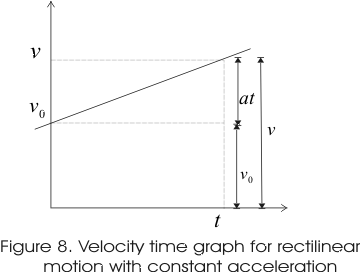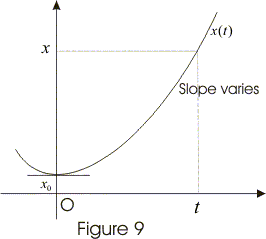6.Kinematic equations for uniformly accelerated Motion
- Motion with constant acceleration or uniformly accelerated motion is that in which velocity changes at the same rate throughout motion.
- When the acceleration of the moving object is constant its average acceleration and instantaneous acceleration are equal. Thus from eq. 5 we have

- Let v0 be the velocity at initial time t=0 and v be the velocity of object at some other instant of time say at t2=t then above eq. 7 becomes
a=v−v0t−0
or , v=v0+at (8) - Graphically this relation is represented in figure 8 given below.

- Thus from the graph it can be seen clearly that velocity v at time t is equal to the velocity v0 at time t=0 plus the change in velocity (at).
- In the same way average velocity can be written as
vavg=x−x0t−0
where x0 is the position of object at time t=0 and vavg is the average velocity between time t=0 to time t.The above equation then gives
x=x0+vavgt (9)
Now we know that area under v-t curve represent the displacement
So,x−x0=12(v−v0)t+v0t as ( Area of Triangle + Area of Rectangle)x−x0=v+v02t
From equation 9 and the above equation we cay say that
vavg = v0 + ½(at) (11)
putting this in eq. 9 we find
x = x0 + v0t + ½(at2)
or,
x - x0 = v0t + ½(at2) (12)
this is the position time relation for object having uniformly accelerated motion. - From eq. 12 it is clear that an object at any time t has quadratic dependence on time, when it moves with constant acceleration along a straight line and x-t graph for such motion will be parabolic in natures shown below.

- Equation 8 and 12 are basic equations for constant acceleration and these two equations can be combined to get yet another relation for x , v and a eliminating t so, from 8

putting this value of t in equation 12 and solving it we finally get,
v2 = (v0)2 + 2a ( x - x0 ) (13) - Thus from equation 13 we see that it is velocity displacement relation between velocities of object moving with constant acceleration at time t and t=0 and their corresponding positions at these intervals of time.
- This relation 13 is helpful when we do not know time t.The above three equations are called the Kinematics equations
v= v0 + at
x - x0 = v0t + ½(at2)
v2 = (v0)2 + 2a ( x - x0 )
If x0 =0,then
v= v0 + at
x= v0t + ½(at2)
v2 = (v0)2 + 2a ( x) - Likewise we can also eliminate the acceleration between equation 8 and 12. Thus from equation 8

putting this value of a in equation 12 and solving it we finally get,
( x - x0 ) = ½ ( v0 + v ) t (14) - Same way we can also eliminate v0 using equation 8 and 12. Now from equation 8
v0 = v - atputting this value of v0 in equation 12 and solving it we finally get,
( x - x0 ) = vt - ½ ( at2 ) (15)
thus equation 15 does not involve initial velocity v0 - Thus these basic equations 8 and 12 , and derived equations 13, 14, and 15 can be used to solve constant acceleration problems.
How to Solve Kinematics equations problem
- Read the question carefully.
- Choose the origin of the coordinates and the axes wherever you would like to make calculation easiar
- Choose one direction as positive . Usually we choose right of the x-axis as positive. The velocity and acceleration in the direction of positive axis will be positive and opposite direction will be negative
- Find out the known and unknown. Consider quantities both at the start and end of the time interval.Also it would be good to translate some stated terms in physical quantities such as starting from rest means v0=0
- Check out which kinematics equation may be useful in this situation and solve accordingly to get the result.Sometime multiple equation may be required to get the solution
- Check for answer If it is reasonable
- Be careful about the units used. It should be same
0 comments:
Post a Comment